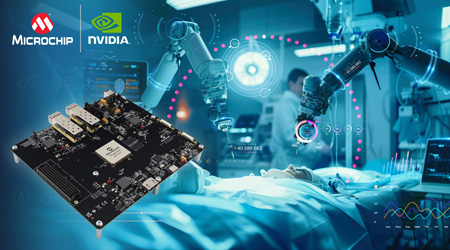PolarFire® FPGA Ethernet Sensor Bridge provides low-power multi-sensor bridging to NVIDIA edge AI platforms

November 15, 2024 — To enable developers building artificial intelligence (AI)-driven sensor processing systems, Microchip Technology (Nasdaq: MCHP) has released its PolarFire® FPGA Ethernet Sensor Bridge that works with the NVIDIA Holoscan sensor processing platform.
PolarFire FPGAs enable multi-protocol support, and this first solution to be released as part of Microchip’s platform is compatible with MIPI® CSI-2®-based sensors and the MIPI D-PHY℠ physical layer. Future solutions will support a wide range of sensors with different interfaces, including SLVS-EC™ 2.0, 12G SDI, CoaXPress® 2.0 and JESD204B. The platform allows designers to leverage the power of the NVIDIA Holoscan ecosystem while taking advantage of the PolarFire FPGA’s power-efficient technology with low-latency communication and multi-protocol sensor support.
NVIDIA Holoscan helps streamline the development and deployment of AI and high-performance computing (HPC) applications at the edge for real-time insights. It brings into a single platform the necessary hardware and software systems for low-latency sensor streaming and network connectivity. The platform includes optimized libraries for data processing, sample AI models for jump-starting AI inference pipeline development, template applications to facilitate rapid prototyping and core microservices to run streaming, imaging and other applications.
With its ability to bridge real-time sensor data to NVIDIA Holoscan and the NVIDIA IGX and NVIDIA Jetson platforms for edge AI and robotics, the PolarFire FPGA Ethernet Sensor Bridge unlocks new edge-to-cloud applications, enables AI/ML inferencing and facilitates the adoption of AI in the medical, industrial and automotive markets.
“The Ethernet sensor bridge is based on Microchip’s highly power-efficient, secure and reliable PolarFire FPGA platform,” said Bruce Weyer, vice president of Microchip’s FPGA business unit. “By combining our flexible FPGA fabric with NVIDIA’s advanced AI platform and multi-protocol support, we’re empowering developers to create innovative, real-time solutions that will revolutionize sensor interfaces across a wide range of powerful AI-driven edge applications.”
By utilizing the low power consumption of Microchip’s PolarFire FPGA technology, the NVIDIA Holoscan Sensor Bridge efficiently manages high-bandwidth data from diverse sensors over Ethernet, enabling real-time, high-performance edge AI processing on NVIDIA AI platforms. The power-efficient design is also conducive for small-footprint and energy- or cost-sensitive applications.
PolarFire FPGAs address security concerns in sensor applications by providing embedded security and safety features to help protect against potential cyber threats and provide physical, device, design and data integrity. They are additionally designed with single event upset (SEU) immunity, making them highly reliable in environments subject to radiation, such as space or high-altitude applications and medical environments. The SEU immunity also helps reduce the risk of data corruption and system failures.
To learn more about how Microchip’s development tool supports NVIDIA Holoscan and other applications, visit the PolarFire FPGA Ethernet Sensor Bridge web page.
Resources
High-res images available through Flickr or editorial contact (feel free to publish):
● Application image: https://www.flickr.com/photos/microchiptechnology/54120582537/sizes/l/






